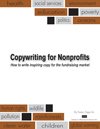Olivia Smith (Senior VP) of BKV, Inc. headed up a six month study on what charities are doing in email. Smith shared many of her findings during a session at the DMANF Conference in New York on August 25th. It was quite fascinating and Smith told me they will be releasing a white paper on the study.
I want to touch on a couple of their findings here. First a bit about their methodology as I understand it from Smith’s presentation:
Goal was to observe the emails from 100 charities of various sizes over 6 months
Their selection criteria included charities with the ability to accept donations online; and the ability to EASILY register/subscribe online to a newsletter or email updates. This second criterion to “easily subscribe” eliminated 25 charities. That’s lesson number ONE – make it easy for prospects and donors to sign-up for your email communications.
Therefore 75 charities were chosen (none of which were clients of BKV, Inc.), in eight verticals: advocacy, animal, sponsorship, children, environmental, health, human services, and international.
A $10 online donation was made with each charity with one email address. And with a different email address than that used for the donation, Smith registered online with the same 75 charities. Then the emails began to flow.
Over the course of six months she received 1546 emails as a result of the $10 donation; and she receive another 1583 emails by simply subscribing.
Want to stand out from the crowd? Karen says . . .
Send BOTH a thank you email for online donations, and a thank you letter or card in the mail. Why? Because in Smith’s study only a handful of charities did this.
I was surprised by this – but maybe I shouldn’t have been – and also disappointed. With the mountains of studies and proof that donors respond more often when communicated with across multiple channels . . . why not start off right by saying thank you online and offline? Begin your relationship with a strong positive first impression through warm cultivation and gratitude.
Lesson number TWO – thank online donors in two ways: Online and offline.
Welcome everyone and share more about what you do
Smith received more “welcome” messages when she subscribed than from her donations. The welcome messages told more of “here’s what we do” and “how you can help.”
Surely the charities don’t assume that just become someone makes a $10 online donation, that donor knows everything about the charity!
This is another MAJOR cultivation opportunity missed by too many charities. Brand new online donors as well as non-donor email subscribers need to be welcomed to your nonprofit.
Share success stories in your welcome that highlight in a simple “show and tell” fashion each of your programs. Briefly introduce planned giving. Share all the ways they can be involved and where to find you (e.g., social media, send them to your YouTube page, events, newsletters, etc.).
Lesson number THREE – welcome everyone. Don’t discriminate.
I could go on and on about this revealing study, but I’ll save the rest for another day. Meanwhile I’ve given you three lessons on improving relationships with your supporters . . . three opportunities for your charity. And they’re all comparatively easy to implement.
